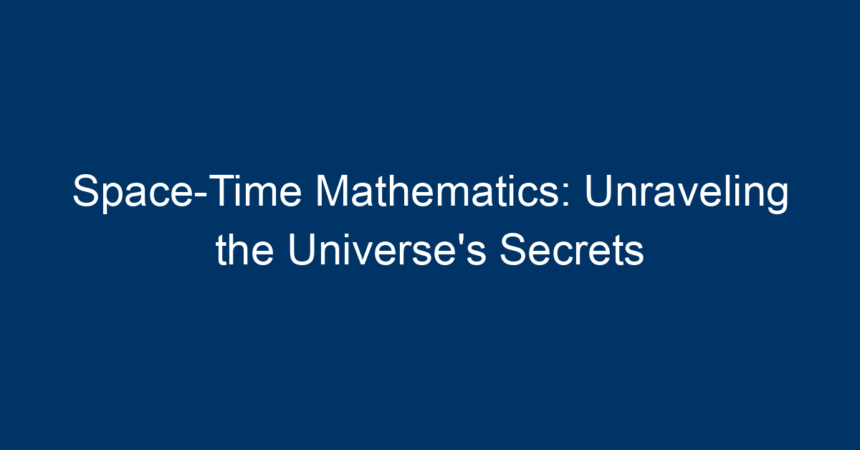The universe is a vast and intricate tapestry of time and space, woven together by the threads of mathematics. At the forefront of this exploration is space-time mathematics, a field that seeks to decode the fundamental laws governing our cosmos. By understanding how space and time interact, scientists are unravelling the secrets of black holes, the Big Bang, and even the fabric of reality itself. In this article, we will delve into the captivating world of space-time mathematics, its significance, and the implications it holds for our understanding of the universe.
What is Space-Time Mathematics?
Space-time mathematics is a branch of theoretical physics that merges the traditional notions of space and time into a single four-dimensional continuum. Rather than treating time as a separate entity from the three dimensions of space, space-time mathematics posits that they are interlinked. This revolutionary idea, largely credited to Albert Einstein through his theory of general relativity, transformed our understanding of gravity and motion.
The History of Space-Time Mathematics
The roots of space-time mathematics can be traced back to the early 20th century, when physicists began to question the foundations of Newtonian mechanics. Einstein’s 1905 Special Theory of Relativity introduced the concept of a four-dimensional space-time, where time is intricately connected with the three dimensions of space. Later, in 1915, his General Theory of Relativity further refined these ideas, describing how mass and energy warp space-time, leading to the gravitational effects we observe.
The Basic Concepts
Before diving deeper into space-time mathematics, it’s essential to grasp some of its fundamental concepts:
-
Four-Dimensional Space-Time: In this model, an event is represented by four coordinates: three spatial dimensions and one temporal dimension. This framework allows physicists to analyze events in ways that traditional three-dimensional models cannot.
-
Metric Tensors: These mathematical structures describe how distances are measured in the curved space-time fabric. The metric tensor is crucial in calculating the curvature caused by mass and energy.
- Geodesics: In space-time, the shortest path between two points is not necessarily a straight line, but rather a geodesic, which accounts for the curvature of space-time caused by gravity.
The Mathematics Behind Space-Time
To fully understand space-time mathematics, we need to delve into some of the equations and principles that govern it.
The Einstein Field Equations
At the heart of space-time mathematics are the Einstein Field Equations (EFE), which relate the geometry of space-time to the energy and momentum of whatever matter and radiation are present. These equations are complex but can be simplified into the following form:
[ G{\mu\nu} + \Lambda g{\mu\nu} = \frac{8\pi G}{c^4} T_{\mu\nu} ]
Where:
- ( G_{\mu\nu} ) is Einstein’s tensor, describing the curvature of space-time.
- ( T_{\mu\nu} ) is the stress-energy tensor, representing matter and energy.
- ( \Lambda ) is the cosmological constant, related to the energy density of empty space.
- ( c ) is the speed of light.
This elegant mathematical relationship shows us how mass and energy shape the world around us.
Special Relativity and Lorentz Transformations
Another critical component of space-time mathematics is special relativity, which introduces the Lorentz transformations. These equations allow us to convert measurements of time and space from one inertial frame to another:
[ t’ = \gamma \left(t – \frac{vx}{c^2}\right) ]
Where:
- ( \gamma ) (gamma) is the Lorentz factor, defined as ( \gamma = \frac{1}{\sqrt{1 – \frac{v^2}{c^2}}} ).
- ( v ) is the velocity of the object in motion.
- ( x ) is the position in space.
These transformations illustrate how time can dilate and lengths can contract depending on the relative speeds of observers, emphasizing the intertwined nature of space and time.
Applications of Space-Time Mathematics
Space-time mathematics has far-reaching applications across various domains, from astrophysics to cosmology. Here are some notable examples:
Black Holes and Singularities
One of the most intriguing applications of space-time mathematics is the study of black holes. The equations governing black holes reveal that mass can curve space-time so intensely that even light cannot escape. This phenomenon leads to the formation of singularities—points where the laws of physics, as we understand them, break down.
The Big Bang Theory
Space-time mathematics also plays a crucial role in understanding the origin of the universe. The Big Bang model, which describes how the universe expanded from an incredibly hot and dense state, relies on these mathematical frameworks. The equations underpinning the expansion provide critical insights into the initial conditions and the overall geometry of the universe.
Gravitational Waves
Recently, advancements in space-time mathematics have led to the prediction and detection of gravitational waves. These ripples in the fabric of space-time are a direct consequence of accelerating masses, like merging black holes or neutron stars. The detection of these waves has opened a new window for observing cosmic events previously thought to be unreachable.
Challenges and Future Directions
While space-time mathematics has provided invaluable insights, challenges remain.
Resolving Infinities
One of the ongoing issues in theoretical physics is the presence of infinities in calculations related to black holes and quantum gravity. Efforts to reconcile general relativity with quantum mechanics have led to numerous theoretical frameworks, including string theory and loop quantum gravity, which seek to address these challenges using advanced mathematical tools.
Quantum Gravity
The quest for a unified theory that combines quantum mechanics and general relativity is at the forefront of contemporary physics. Space-time mathematics is central to this endeavor, as it provides the structural foundation needed to explore and potentially resolve the discrepancies between these two pillars of modern physics.
Conclusion: The Path Ahead
As we continue to explore the universe through the lens of space-time mathematics, we are reminded of the profound interconnectedness of space and time. This field not only helps us unravel the secrets of the cosmos but also challenges our perceptions of reality itself.
Actionable Insights
-
Embrace Learning: Whether you’re a student or a seasoned scientist, delving into space-time mathematics can significantly enhance your understanding of the universe. Numerous online courses and resources can guide you.
-
Stay Informed: Follow the latest research in the field. Journals and online platforms like arXiv and NASA’s website often publish groundbreaking studies related to space-time mathematics.
- Engage with the Community: Participate in forums or groups that discuss theoretical physics, mathematics, and cosmology. Engaging with others can provide new insights and foster collaborative learning.
In the quest to understand our universe, space-time mathematics is not just a set of equations; it is a lens through which we can glimpse the very fabric of reality. As research continues, who knows what new secrets we might uncover next?




